The cases might be rare, but these are the killers cops fear most
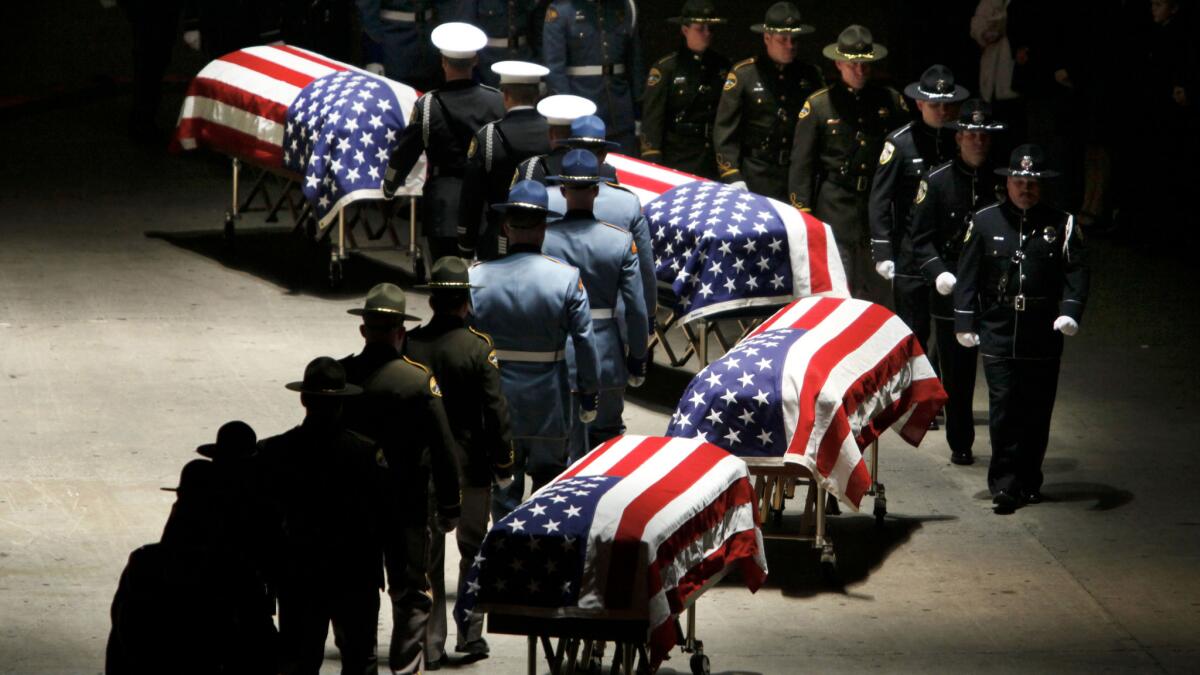
- Share via
The patrol car pulled to the curb on a damp Halloween night in Seattle.
Following behind in an old Datsun 210, Christopher Monfort passed slowly and turned right.
Monfort, 41, had come to this quiet waterfront neighborhood to launch a revolution. He was obsessed with the Constitution, and saw police brutality as a rising tyranny. He equated officers with the Redcoats. And tonight he was out to hunt them with a .223 Kel-Tec assault rifle.
From inside the patrol car, police trainee Britt Sweeney saw a white flash burst like a lightning strike. The top of her head seared in pain as six more shots rang out. Officer Timothy Brenton hadn’t fired a shot, and Sweeney soon saw why: He was sitting upright in the driver’s seat, with head wounds so grievous she didn’t need to check his pulse.
Barely a month later, 40 miles to the south, it happened again: A man walked into a coffee shop and shot four Lakewood Police Department officers dead.
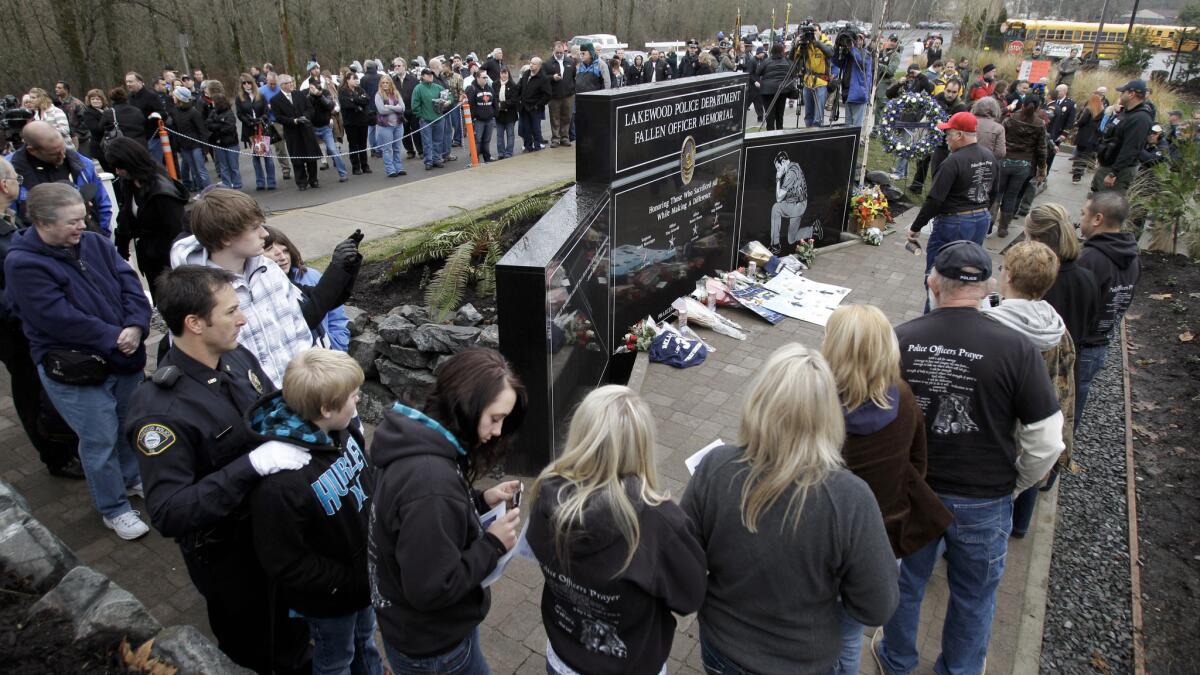
The shootings convulsed the region that fall of 2009, much as the killings this summer of eight police officers in Dallas and Louisiana stunned the nation, and the killings Saturday of two Palm Springs police officers rattled Southern California.
A total of 12 officers have been killed in premeditated ambushes so far this year, two more than the last two years combined, according to FBI statistics.
Police assassins have included a ragtag smattering of white survivalists, black militants, people who identify with the antigovernment “sovereign citizen” movement, hard-core criminals who have clashed with law enforcement for much their lives, and a variety of apparently suicidal people who wanted to depart with notoriety.
In two of the most recent ambush attacks against police — in Dallas, where five officers were stalked and killed and nine others were injured in July; and 10 days later in Baton Rouge, where six officers were shot, three of them fatally — the killers were African American. In Palm Springs, where police say officers were lured into a trap, the suspected gunman is Latino.
Although most police shooters are white males, including Latinos, black men have been responsible for nearly 40% of the 232 ambush killings of police officers since 2002, according to a U.S. Department of Justice study last year.
For their portion of the population, black men have ambushed and killed officers at a rate three times that of white men.
Criminologists widely attribute the higher level of violence among African Americans to entrenched socioeconomic disadvantages and resentment of police.
“High levels of poverty, higher levels of joblessness, neighborhood instability — people moving in and out — these contribute to the racial differences in violent offending, specifically homicide,” said Richard Rosenfeld, criminology professor at the University of Missouri-St. Louis. “Also, high levels of discontent with the police and the degree with which police patrol their communities in an unbiased way.”
The shootings in Dallas and Baton Rouge came at a time of heightened racial unrest over recent police killings of African Americans. They happened just days after the videotaped shootings of Alton Sterling in Baton Rouge on July 5 and Philando Castile in Minnesota on July 6.
Micah X. Johnson, a 25-year-old Afghanistan veteran, opened fire on officers at an otherwise peaceful Black Lives Matter rally in Dallas.
The shooter in Baton Rouge was identified as Gavin Eugene Long, 29, an Iraq veteran with a history of espousing violence against white “oppressors.”
In one of the many videos Long had posted, he depicted violence against authorities as part of a David-and-Goliath struggle. “One hundred percent of revolutions, of victims fighting their oppressors, from victims fighting their bullies, 100% have been successful through fighting back through bloodshed,” he said.
In Palm Springs, authorities say they are still trying to learn more about what may have motivated John Felix, 26, to put on body armor and grab an assault rifle with an extended magazine and wait for officers to respond to a disturbance call. A gang member who did 18 months in state prison for assault with a deadly weapon, Felix opened fire through a metal security gate, killing Officers Lesley Zerebny, 27, and Jose “Gil” Vega, 63, just as they arrived, authorities say.
“He wanted to gun down police officers because they wore the uniform,” Riverside County Dist. Atty. Michael Hestrin said at a news conference on Wednesday. “He was deliberate in his actions. He attacked the officers for no reason other than they were officers coming to a call.”
In the Seattle case, Monfort had a white mother and estranged black father. He had lived all over the country, and as a boy was the only black person in his town in Indiana.
While he harbored soaring ambitions, talking of attending Harvard Law School, he mostly drove trucks and worked security, before finally getting his bachelor’s degree from the University of Washington in 2008 at age 39.
In class, he was a passionate, occasionally vitriolic student who saw himself as a protector of the Constitution, according to court testimony and a Seattle Times profile. He studied the disproportionate number of drug convictions for black people in Washington, and became outraged at a videotape that showed deputies beating up a 15-year-old girl in a holding cell.
King County prosecuting attorney John Castleton said Monfort told his friends he wanted to stop such behavior, but he never revealed plans, just frustration. “With Monfort, no one saw it coming,” Castleton said.
By Oct. 22 of 2009, his war began.
He firebombed police cars in a maintenance yard, and left a note referencing the jailhouse beating. Nine days later, Monfort launched his Halloween attack on the two officers in their parked car.
At his trial last year, defense experts argued that Monfort had a delusional disorder that made him believe killing officers was a moral act protected by the Constitution because it would stem police abuse.
Castleton argued that the killer’s motivation was simple hatred, and the jury found him guilty of first-degree murder. He was sentenced to life in prison.
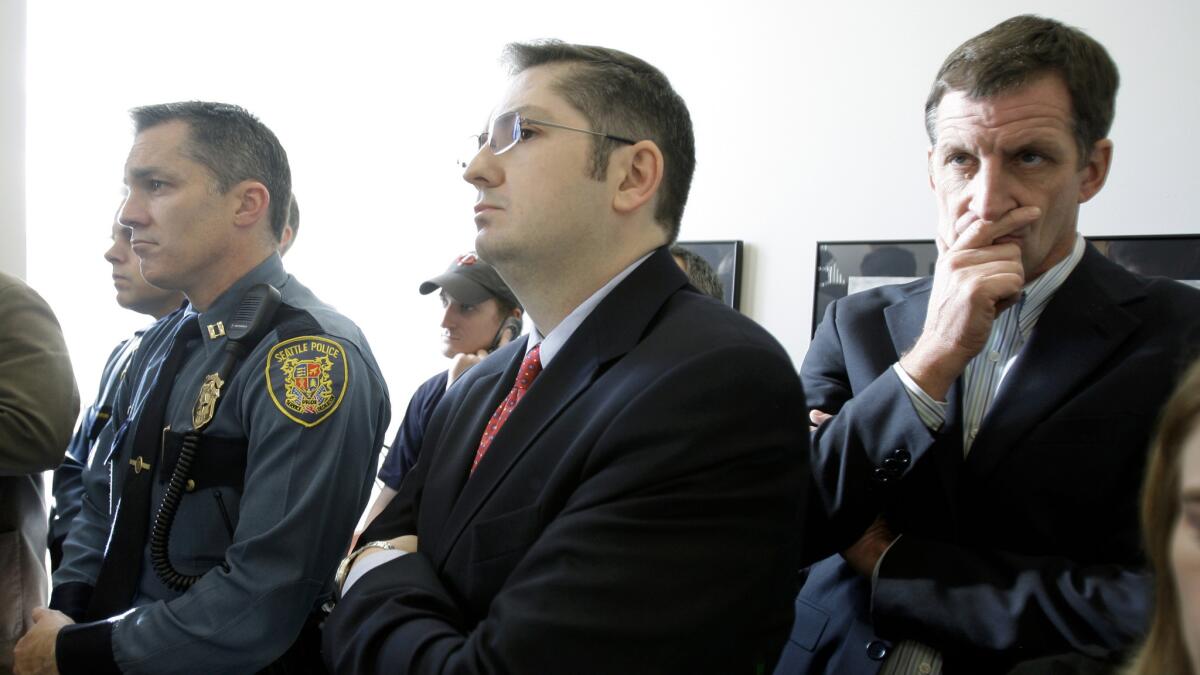
Maurice Clemmons, the shooter in the second Seattle-area attack that year, didn’t come by his hatred through social media or academic studies, but by a life of run-ins with the police. A habitual thief since he was a teenager in Arkansas, Clemmons, who is black, had spent 14 years in prison by age 32. He moved to Washington to start a new life, and worked a series of jobs.
Family members say he had a psychological breakdown in the spring of 2009. He saw himself as Jesus Christ, his wife as Eve and then-French President Nicolas Sarkozy as the devil, according to a book on the case, “The Other Side of Mercy,” by Seattle Times reporters Ken Armstrong and Jonathan Martin. He told people that God was “lining up all his soldiers in the penitentiaries.”
On May 9, he started throwing large rocks through neighbors’ windows and then punched and wrestled the deputies who responded. When they finally subdued and arrested him, Clemmons declared: “White people will be killed if they do not right their ways. This will happen in the biblical sense.”
Clemmons was released on bond. If authorities had listened to many of the recorded calls he made in jail, they might have anticipated the violence to come.
“Sometimes it burns me in the chest, man, I have so much hatred for the police,” he told a friend during one call in September, according to Armstrong and Martin’s book. “The strategy is gonna go, kill as many of them devils as I can, until I can’t kill no more. . . . I ain’t no more catch the cuffs. I’m going to war.”
On Nov. 29, four officers of the Lakewood Police Department lay dead at the Forza Coffee Co. in Parkland, Wash. Clemmons was killed by police at the conclusion of a statewide manhunt three days later.
Ambushes of more than two officers are exceedingly rare, and this was the worst in decades, getting nationwide attention. It had been 16 years since four federal agents were gunned down during a raid of the Branch Davidian compound near Waco, Texas, but that was during a high-risk tactical situation, not an unprovoked attack.
Most ambush attacks on police are launched by gunmen acting alone, with little pre-planning, according to the 2015 Justice Department study, and despite the rising numbers, police officers are still far more likely to be killed during traffic stops and pursuits, serving search warrants, responding to calls and investigating suspicious activity.
“Premeditated ambushes are extremely rare events,” said George Fachner, a Justice Department researcher who co-wrote the study.
From 2004 to 2013, about 11 officers were killed on average each year in ambushes. While those numbers dropped in 2014, the premeditated attacks began to rise.
The first came that June in Nevada, and it involved a white couple, Jerad and Amanda Miller, who had migrated to Las Vegas from Indiana to start a new life. He was a convicted drug dealer and car thief, disowned by his family, unable to get a job. She was nine years younger, 22, and came to buy his extremist antigovernment beliefs, much to the dismay of her parents.
They joined the movement to support Nevada rancher Cliven Bundy, who had become locked in conflict with the federal government over grazing rights.
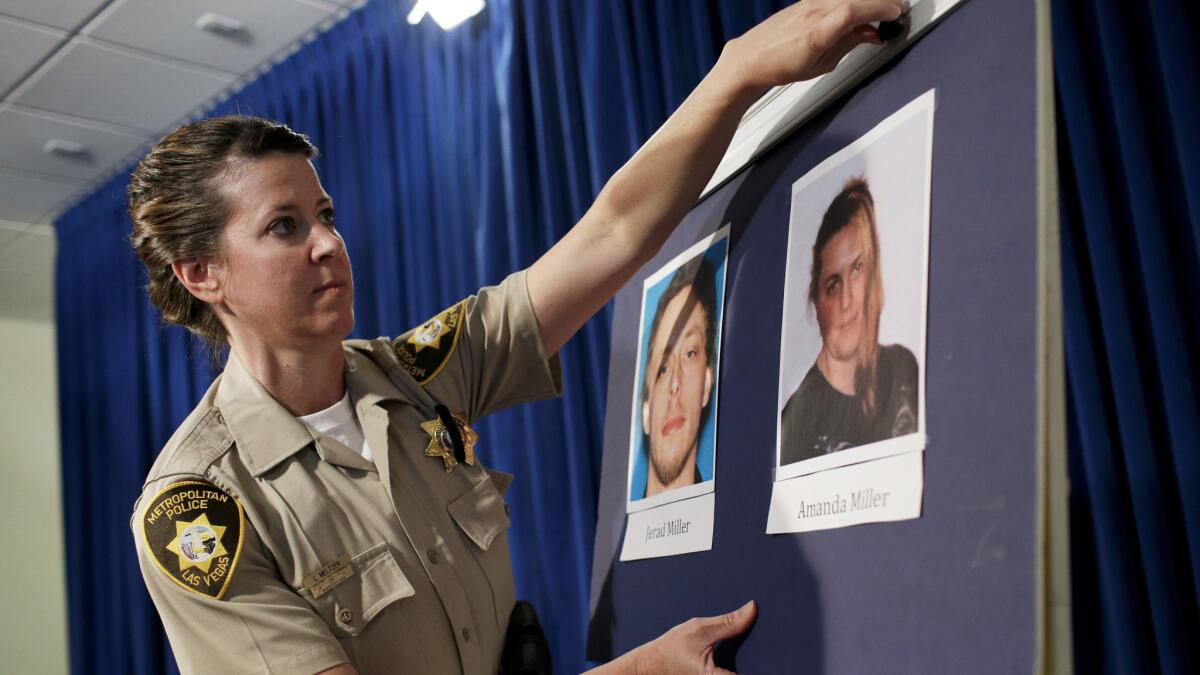
Jerad Miller began to write about the need to fight a “tyrant’s wrath,” and Amanda watched radical videos with titles such as “When is it OK to Shoot a Cop?”
His views came from an entirely different political constellation than the African American anger of Monfort, Johnson and Long, and yet they drew a bead on the same target.
On June 8, 2014, the Millers walked into a pizzeria in east Las Vegas and shot two police officers to death. The couple fled to a nearby Wal-Mart, where they shot another man, and were killed themselves as police closed in.
Next hit was Pennsylvania, in the Pocono Mountains two months later. A state trooper stepped out the door of his station and was struck fatally by a .308-caliber rifle shot from the surrounding woods. A second trooper walking in from the parking lot was hit next and managed to crawl to safety inside.
Pennsylvania police launched one of the largest manhunts in state history for the suspect, Eric Frein, a white survivalist and self-trained sniper who had an obsession with the Serbian army and paramilitary groups.
He hid in the woods for seven weeks before he was caught without incident. He awaits trial.
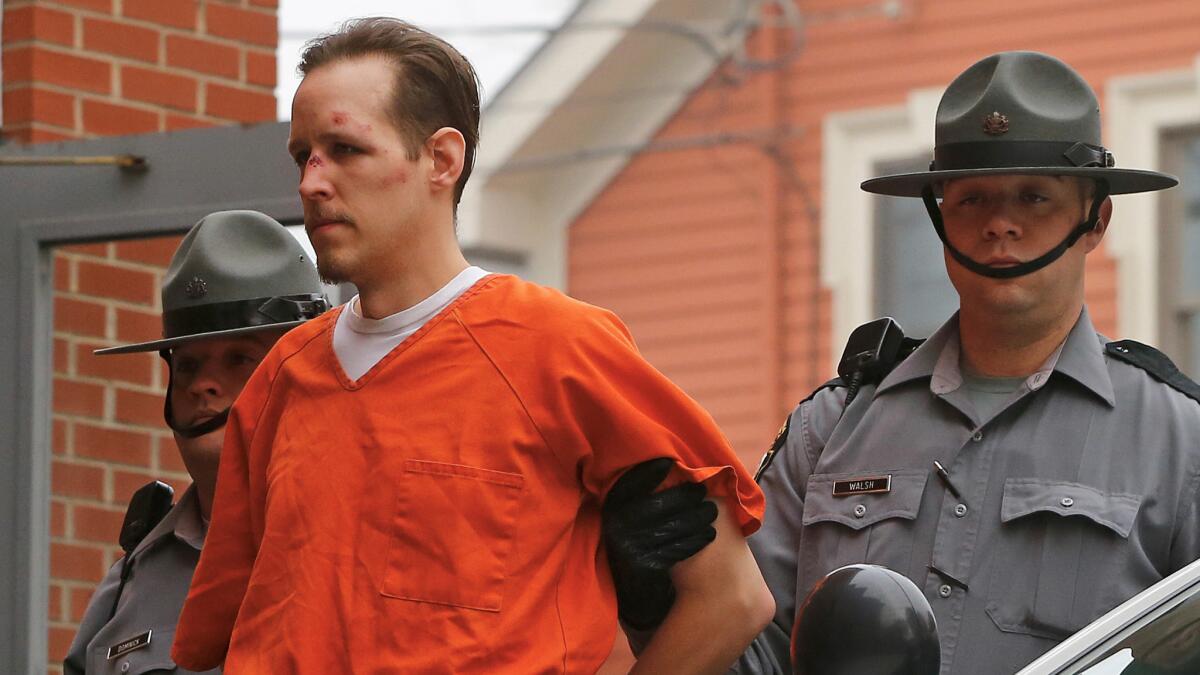
In Tallahassee, Fla., on Nov. 22, 2014, Curtis Holley, a 53-year-old white man, lighted his house on fire and shot the first deputies arriving on the scene, killing one, wounding another. His girlfriend had just left him, his utilities had been shut off, and law enforcement said he harbored antigovernment views. After a 12-minute gun battle, an off-duty officer responding to the incident killed Holley.
The next month in Brooklyn, New York Police Officers Rafael Ramos and Wenjian Liu were shot to death sitting in their patrol car.
The shooter, Ismaaiyl Brinsley, a 28-year-old black man, had apparently started out that morning intending to kill himself. A hustler and thief, Brinsley suffered from bouts of depression and had faced a string of arrests for mostly minor crimes that kept him from getting steady work. He went to his ex-girlfriend’s house in suburban Baltimore and pointed a 9-millimeter pistol at his head. She talked him out of killing himself, but then he shot her, and headed to Brooklyn.
No one knew Brinsley to be an anti-police activist or to talk about hurting cops. Yet suddenly he posted on Instagram that he planned to kill two officers, citing the police killings of Michael Brown in Ferguson, Mo., and Eric Garner in Staten Island, N.Y., both black men, earlier that year.
Brinsley killed himself immediately after shooting the officers.
Last year saw a drop in premeditated killings, while this year saw a sharp rise, a consequence of the high body count wrought in Dallas, Baton Rouge and Palm Springs.
The FBI counts two other premeditated killings this year: an officer in Danville, Ohio, killed by a 32-year-old white man, who told his girlfriend he was going hunting for police; and an officer in Euless, Texas, shot to death by a 22-year-old Latino man who had a long criminal history and deep-seated hatred for police.
One of the most vexing ambushes in recent years occurred outside Bardstown, Ky., in the predawn hours of May 25, 2013.
No one has a clue why it happened.
Police Officer Jason Ellis, a father of two young boys, was heading home at 2 a.m., rounding the off-ramp from the Bluegrass Parkway to Route 55 north, when he stopped to remove some branches on the road. Under a full moon, three blasts of a 12-gauge shotgun cracked the still night, killing Ellis instantly.
“We believe it was a trap set for him,” said Bardstown’s current police chief, McKenzie Mattingly. “From a tactical standpoint, it was a perfectly laid ambush.”
Three years later, the killing is still a mystery.

“People are crazy this day and age,” Mattingly said. “They might be arrested for a DUI, and they lose their job because they can’t drive, and their wife leaves them and they become convinced that Jason Ellis ruined their life.”
Mattingly said it has shattered officers’ sense of safety. He doesn’t go to the grocery store or mow his lawn unarmed. When he takes a shower, he locks all the doors.
“If an officer here tells you he isn’t scared, he’s lying,” he said. “They hunted down one of our own like a dog.”
ALSO
Suspect in Palm Springs police killings had body armor and high-capacity magazines, authorities say
‘I can’t think of a better cop.’ Palm Springs officer killed three months before retirement
UPDATES:
9:50 p.m., Oct. 12: The story was updated with details about the killing of two police officers in Palm Springs.
The story was originally published at 3 a.m. Oct. 10.
More to Read
Sign up for Essential California
The most important California stories and recommendations in your inbox every morning.
You may occasionally receive promotional content from the Los Angeles Times.











